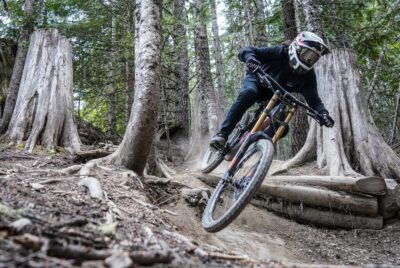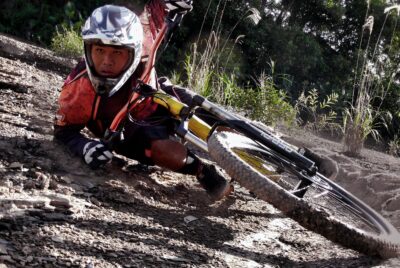Time Mountain Bike Jumps
Mountain biking is a thrilling adventure that allows riders to conquer challenging terrain, experience the rush of speed, and connect with nature in a unique way. As an avid mountain biker, I understand the excitement and challenges that come with navigating jumps and descents. In this article, I’ll share valuable insights and practical tips on how to time mountain bike jumps effectively and break bad descending habits. By mastering these skills, you can enhance your riding experience, boost confidence, and stay safe on the trails.
Introduction
Mountain biking is not just about pedalling uphill or cruising on flat trails—it’s about the exhilarating moments when you soar through the air after launching off a jump. However, timing jumps correctly is crucial for a safe and enjoyable experience. It’s equally important to address any bad descending habits that may hinder your performance and put you at risk. By understanding the principles behind timing jumps and breaking bad habits, you can take your mountain biking skills to new heights.
The Importance of Timing Mountain Bike Jumps
Timing jumps is essential for several reasons. Firstly, it ensures your safety by allowing you to clear obstacles smoothly and land securely. Additionally, proper timing maximizes airtime, enabling you to perform tricks and stunts with finesse. Mistimed jumps, on the other hand, can result in crashes, loss of control, and even serious injuries. By honing your timing skills, you’ll experience greater control, confidence, and enjoyment during your jumps.
Techniques for Timing Mountain Bike Jumps
Timing jumps requires a combination of speed management, body positioning, and technique. Here are some key techniques to help you master this skill:
Speed Management:
Approach jumps at an appropriate speed that allows you to clear the gap comfortably. Too much speed can lead to overshooting, while insufficient speed may cause you to come up short. Practice finding the right balance by gradually increasing or decreasing your speed.
Body Positioning:
Position your body correctly to maintain stability and control during takeoff and landing. Keep your knees and elbows bent, distributing your weight evenly on the bike. Leaning slightly back as you leave the lip of the jump will help maintain balance in the air.
Visual Focus:
Look ahead and focus on the landing zone rather than the gap itself. Your body will naturally follow your gaze, aiding in smooth and accurate landings.
By implementing these techniques and practicing them consistently, you’ll improve your ability to time jumps effectively and execute them with confidence.
Breaking Bad Descending Habits
While timing jumps is crucial, it’s equally important to address any bad descending habits that can hinder your performance and compromise your safety. Here are some common descending mistakes to be aware of:
Overbraking:
Excessive braking while descending can rob you of momentum, making it harder to navigate technical sections and jumps.
Poor Line Selection:
Choosing incorrect lines can result in slower speeds, inefficient riding, and potential hazards. Learning to identify the optimal lines through different trail features is key.
Improper Body Position:
A stiff and rigid body position limits your ability to absorb impacts, adjust to changing terrain, and maintain balance. Keeping your body loose and relaxed allows for better bike control and smoother descents.
By identifying and addressing these bad habits, you can enhance your overall descending technique, improve speed, and increase your ability to tackle challenging terrain with confidence.
Tips for Breaking Bad Descending Habits
To break bad descending habits and elevate your riding skills, consider the following tips:
Braking Finesse:
Learn to modulate your brakes smoothly, applying the right amount of pressure at the right time. Gradually release the brakes as you gain confidence, allowing you to maintain speed and control.
Line Selection:
Study the trail ahead and identify the smoothest and most efficient lines. Practice taking these lines consistently to build muscle memory and improve your ability to maintain flow.
Body Positioning:
Stay loose and relaxed, allowing your body to move with the bike. Flex your knees and elbows to absorb impacts and maintain stability. This dynamic posture will help you react quickly to changing trail conditions.
By implementing these tips and practicing them during your rides, you’ll gradually break bad descending habits and develop a more efficient and effective riding style.
Building Confidence and Skill
Building confidence and skill is a continuous process in mountain biking. Here are some additional suggestions to help you progress:
Practice Regularly:
Dedicate specific sessions to practicing jumps and descents. Start with smaller features and gradually work your way up to more challenging ones. Repetition is key to ingraining proper technique and building confidence.
Ride with Skilled Riders:
Surrounding yourself with experienced riders provides an opportunity to observe their techniques and gain inspiration. Riding with others who are more proficient can also push you to step outside your comfort zone and improve your skills.
Visualize Success:
Mental rehearsal is a powerful tool. Visualize yourself successfully timing jumps and executing smooth descents. This technique helps build confidence and prepares your mind for optimal performance.
Remember, progress takes time and dedication. Embrace the learning process, celebrate small victories, and be patient with yourself. With perseverance, you’ll soon find yourself surpassing your previous limits and riding with greater skill and confidence.
Conclusion
Timing mountain bike jumps and breaking bad descending habits are integral aspects of becoming a skilled and confident rider. By mastering these skills, you’ll experience safer and more exhilarating rides while pushing your limits on the trail. Remember to practice the techniques outlined, seek improvement with every ride, and never shy away from challenges. With time, dedication, and a willingness to learn, you’ll become a more proficient rider and unlock new levels of enjoyment in the world of mountain biking.
FAQs
FAQ 1: Is timing jumps only important for advanced riders?
No, timing jumps is essential for riders of all skill levels. It ensures safety and enhances the overall riding experience. Start with smaller jumps and gradually progress as your skills improve.
FAQ 2: How can I overcome fear when attempting jumps?
Start by practicing on small jumps and gradually work your way up. Focus on proper technique and build confidence through repetition. Progress at your own pace and never rush the learning process.
FAQ 3: Can bad descending habits affect my speed and control?
Yes, bad descending habits can hinder your speed, control, and overall performance. By breaking these habits and adopting proper techniques, you’ll notice significant improvements in your riding abilities.
FAQ 4: Should I invest in protective gear for jumps and descents?
Absolutely! Wearing appropriate protective gear such as a helmet, knee pads, and elbow guards is crucial for your safety when attempting jumps and descents. Always prioritize your well-being.
FAQ 5: How long does it take to master timing jumps and breaking bad descending habits?
The time it takes to master these skills varies from person to person. Consistent practice, focus on technique, and gradually increasing the difficulty of jumps and descents will help accelerate your progress. Be patient and enjoy the journey of improvement.




